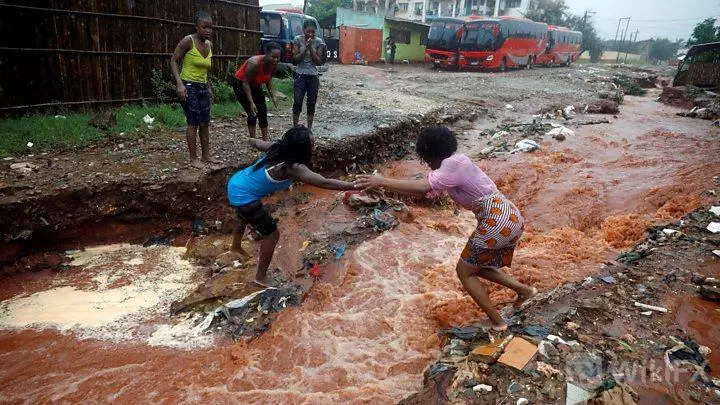简体中文
繁體中文
English
Pусский
日本語
ภาษาไทย
Tiếng Việt
Bahasa Indonesia
Español
हिन्दी
Filippiiniläinen
Français
Deutsch
Português
Türkçe
한국어
العربية
Mozambique cyclone: Death toll rises as storm blocks aid
Abstract:Image copyrightReutersImage caption Pemba, the regional capital, has experienced more than 2m (6.5f
Image copyrightReutersImage caption
Pemba, the regional capital, has experienced more than 2m (6.5ft) of rain and flooding
{2}
The death toll in cyclone-hit northern Mozambique has risen to 38, officials say, as aid workers struggle to reach the worst-affected areas.
{2}
Cyclone Kenneth struck the southern African nation last week with winds of 220km/h (140mph), flattening villages and damaging thousands more homes.
The storm lost strength, but torrential rain and high winds were still battering the area on Monday.
As a result, flights have been grounded - hindering the aid effort.
It is predicted the weather system will dump twice as much rainfall as Cyclone Ida when it struck last month, leaving more than 900 dead across Mozambique, Malawi and Zimbabwe.
Africa Live: Update on the aftermath of Cyclone Kenneth, and other stories
The flood risk was compounded by Kenneth hitting at the end of the rainy season when river levels were already high, the UN's Office for the Co-ordination of Humanitarian Affairs (Ocha) noted.
Already, Pemba, the regional capital of Cabo Delgado state, has experienced more than 2m (6.5ft) of rain and flooding.
What's the latest?
According to Mozambique's National Institute of Disaster Management (INGC), 38 people have been killed by Cyclone Kenneth, while another 35,000 homes have been destroyed or damaged.
The privately-owned O Pais website reported five people died after part of a rubbish dump collapsed onto homes in Pemba on Sunday evening. It is unclear if these deaths are recorded in the government total.
Ocha says humanitarian needs “have sky-rocketed, and the humanitarian response will need to rapidly scale-up”.

Media playback is unsupported on your device
Media captionCyclone Kenneth left roads looking like waterfalls
Some 200,000 are in danger in Pemba alone, Ocha warned. Spokesman Saviano Abreu added that the situation in the northern towns of Macomia and Quissanga was critical, while there were also worries for the cut-off island of Ibo.
But attempts to reach those areas had not been entirely successful.
“We managed to send one flight with World Food Programme (WFP) supplies of rice and biscuits, and some non-food items,” Mr Abreu told news agency AFP.
“But unfortunately the weather conditions are changing too fast and threatening the operation. It's raining again and the second flight couldn't go.”
This satellite image shows the cyclone over northern Mozambique and Tanzania on Friday night.
{21}
On Sunday a spokesman for UN Secretary-General Antonio Guterres said he had appealed for “additional resources” from the international community “to fund the response in the immediate, medium and longer term”.
{21}
What is the affected area like?
Cabo Delgado province is not as densely populated as the area hit by Cyclone Idai, and there is apparently more high ground there.
That, in addition to warnings by authorities ahead of the storm, could significantly stem losses compared with Cyclone Idai.

Media playback is unsupported on your device
Media captionSarah Keith-Lucas presents an update on the impact from Cyclone Kenneth
But reports said many thousands of homes had been flattened by the winds, and the area has been hit by militant Islamist violence in recent months, which could complicate humanitarian operations.
Thousands of people had already fled their homes to seek shelter from violence in camps for displaced people.
Disclaimer:
The views in this article only represent the author's personal views, and do not constitute investment advice on this platform. This platform does not guarantee the accuracy, completeness and timeliness of the information in the article, and will not be liable for any loss caused by the use of or reliance on the information in the article.
WikiFX Broker
Latest News
Good News Malaysia: Ready for 5% GDP Growth in 2025!
How to Automate Forex and Crypto Trading for Better Profits
Is the stronger dollar a threat to oil prices?
Rising Risk of Japan Intervening in the Yen's Exchange Rate
How Far Will the Bond Market Decline?
U.S. to Auction $6.5 Billion in Bitcoin in 2025
Standard Chartered Secures EU Crypto License in Luxembourg
Trading Lessons Inspired by Squid Game
Is Infinox a Safe Broker?
How Did the Dollar Become the "Dominant Currency"?
Currency Calculator






